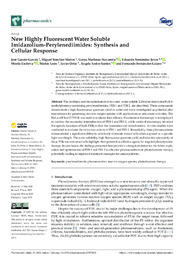Por favor, use este identificador para citar o enlazar este ítem:
https://hdl.handle.net/11000/36799Registro completo de metadatos
| Campo DC | Valor | Lengua/Idioma |
|---|---|---|
| dc.contributor.author | Garcés Garcés, José | - |
| dc.contributor.author | Sánchez Martos, Miguel | - |
| dc.contributor.author | Martinez Navarrete, Gema | - |
| dc.contributor.author | Fernández Jover, Eduardo | - |
| dc.contributor.author | Encheva, Mirela | - |
| dc.contributor.author | León, Martín | - |
| dc.contributor.author | Sastre Santos, Ángela | - |
| dc.contributor.author | Fernández Lázaro, Fernando | - |
| dc.contributor.other | Departamentos de la UMH::Farmacología, Pediatría y Química Orgánica | es_ES |
| dc.date.accessioned | 2025-06-20T10:08:18Z | - |
| dc.date.available | 2025-06-20T10:08:18Z | - |
| dc.date.created | 2023 | - |
| dc.identifier.citation | Pharmaceutics 2023, 15, 1892 | es_ES |
| dc.identifier.issn | 1999-4923 | - |
| dc.identifier.uri | https://hdl.handle.net/11000/36799 | - |
| dc.description.abstract | The synthesis and characterization of two new water soluble 2,6-bis(imidazolylmethyl)-4- methylphenoxy-containing perylenediimides, PDI-1 and PDI-2, are described. These compounds demonstrate a high fluorescence quantum yield in water and were investigated as potential photosensitizers for generating reactive oxygen species with applications in anticancer activities. The HeLa cell line (VPH18) was used to evaluate their efficacy. Fluorescence microscopy was employed to confirm the successful internalization of PDI-1 and PDI-2, while confocal microscopy revealed the specific locations of both PDIs within the lysosomes and mitochondria. In vitro studies were conducted to evaluate the anticancer activity of PDI-1 and PDI-2. Remarkably, these photosensitizers demonstrated a significant ability to selectively eliminate cancer cells when exposed to a specific light wavelength. The water solubility, high fluorescence quantum yield, and selective cytotoxicity of these PDIs toward cancer cells highlight their potential as effective agents for targeted photodynamic therapy. In conclusion, the findings presented here provide a strong foundation for the future exploration and optimization of PDI-1 and PDI-2 as effective photosensitizers in photodynamic therapy, potentially leading to improved treatment strategies for cancer patients. | es_ES |
| dc.format | application/pdf | es_ES |
| dc.format.extent | 18 | es_ES |
| dc.language.iso | eng | es_ES |
| dc.publisher | MDPI | es_ES |
| dc.rights | info:eu-repo/semantics/openAccess | es_ES |
| dc.subject | perylenediimide | es_ES |
| dc.subject | photosensitizer | es_ES |
| dc.subject | reactive oxygen species | es_ES |
| dc.subject | photodynamic therapy | es_ES |
| dc.subject.other | CDU::5 - Ciencias puras y naturales::54 - Química | es_ES |
| dc.title | New Highly FluorescentWater Soluble Imidazolium-Perylenediimides: Synthesis and Cellular Response | es_ES |
| dc.type | info:eu-repo/semantics/article | es_ES |
| dc.relation.publisherversion | https://doi.org/10.3390/pharmaceutics15071892 | es_ES |

Ver/Abrir:
New Highly Fluorescent Water Soluble Imidazolium-Perylenediimides_ Synthesis andCellular Response.pdf
4,47 MB
Adobe PDF
Compartir:
Los ítems de DSpace están protegidos por copyright, con todos los derechos reservados, a menos que se indique lo contrario.
.png)